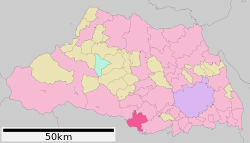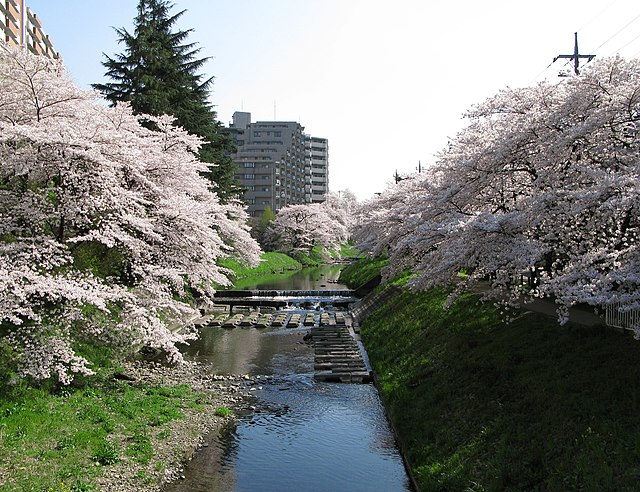Iruma, Saitama
City in Kantō, Japan From Wikipedia, the free encyclopedia
City in Kantō, Japan From Wikipedia, the free encyclopedia
Iruma (入間市, Iruma-shi) is a city located in Saitama Prefecture, Japan. As of 1 January 2021[update], the city had an estimated population of 147,166 in 66,516 households and a population density of 3,300 inhabitants per square kilometre (8,500/sq mi).[1] The total area of the city is 44.69 square kilometres (17.25 sq mi).
Iruma
入間市 | |
|---|---|
 Iruma City Hall | |
 Location of Iruma in Saitama Prefecture | |
| Coordinates: 35°50′8.9″N 139°23′28.1″E | |
| Country | Japan |
| Region | Kantō |
| Prefecture | Saitama |
| Government | |
| • Mayor | Richirō Sugiyama (from November 2020) |
| Area | |
• Total | 44.69 km2 (17.25 sq mi) |
| Population (January 2021) | |
• Total | 147,166 |
| • Density | 3,300/km2 (8,500/sq mi) |
| Time zone | UTC+9 (Japan Standard Time) |
| - Tree | Zelkova serrata |
| - Flower | Camellia sinensis |
| - Bird | Eurasian skylark |
| Phone number | 04-2964-1111 |
| Address | 1-16-1 Toyooka, Iruma-shi, Saitama-ken 358-8511 |
| Website | Official website |


Located in the Sayama Highlands of far southern Saitama Prefecture, Iruma is bordered by Tokyo to the south. The Iruma River flows through the city.
Iruma has a humid subtropical climate (Köppen: Cfa) characterized by warm summers and cool winters with light to no snowfall. The average annual temperature in Iruma is 14.1 °C (57.4 °F). The average annual rainfall is 1,481 mm (58.3 in) with September as the wettest month. The temperatures are highest on average in August, at around 25.9 °C (78.6 °F), and lowest in January, at around 3.2 °C (37.8 °F).[2]
Per Japanese census data,[3] the population of Iruma has recently plateaued after several decades of strong growth.
| Year | Pop. | ±% |
|---|---|---|
| 1960 | 36,903 | — |
| 1970 | 65,639 | +77.9% |
| 1980 | 104,034 | +58.5% |
| 1990 | 137,585 | +32.3% |
| 2000 | 147,909 | +7.5% |
| 2010 | 149,872 | +1.3% |
| 2020 | 145,671 | −2.8% |
The area around Iruma was part of ancient Musashi Province and was noted for kilns producing Sue ware pottery in the Nara period and Heian period. During the Edo period, the area developed as a series of three post towns on the Nikkō Wakiōkan highway during the Edo period. The town of Toyooka and villages of Kaneko, Miyadera, Fujisawa and Higashikaneko were created within Iruma District, Saitama with the establishment of the modern municipalities system on April 1, 1889. The Imperial Japanese Army Air Academy established an airfield in the area in 1938, which later developed into Iruma Air Base. On April 1, 1954, Higashikaneko became Seibu Town. On September 30, 1956, Toyooka, Kaneko, Miyadera, Fujisawa and Seibu merged to form the town of Musashi. Musashi was elevated to city status on November 1, 1966, becoming the city of Iruma. Discussions to merge with the neighboring city of Sayama in 2005 failed to pass a referendum. In 2017 Japan became the first country ever to elect an openly transgender man to any public office when Tomoya Hosoda was elected as a councillor for the city of Iruma.[4][5]
Iruma has a mayor-council form of government with a directly elected mayor and a unicameral city council of 22 members. Iruma contributes two members to the Saitama Prefectural Assembly. In terms of national politics, the city is part of Saitama 9th district of the lower house of the Diet of Japan.
Iruma has a mixed economy with numerous industrial parks for light manufacturing and also serves as a regional commercial center. Due to its location, it is also a bedroom community for people commuting to the Tokyo metropolis for work. In terms of agriculture, Iruma and neighboring Sayama are famous for the green tea they produce.
![]() Seibu Railway - Seibu Ikebukuro Line
Seibu Railway - Seibu Ikebukuro Line
Iruma is twinned with:
Seamless Wikipedia browsing. On steroids.
Every time you click a link to Wikipedia, Wiktionary or Wikiquote in your browser's search results, it will show the modern Wikiwand interface.
Wikiwand extension is a five stars, simple, with minimum permission required to keep your browsing private, safe and transparent.